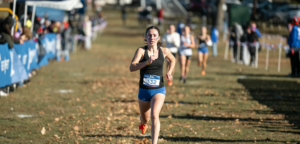By Peter Larson
As coaches, one of our biggest battles is making sure that our athletes do the little things right. Whether it be eating, hydration, sleep, or the importance of a good warmup and cooldown, it can sometimes feel like a futile effort to make sure that our athletes are doing all of the things outside of competition that are needed to maximize performance. And to the athletes who might be reading this – those little things can make a huge difference in the outcome of your competition!

In this post, my first in what I hope will be a new, continuing series here on NHXCTF, I want to hone in on one of these little things – the warmup. At Coe-Brown, I coach the sprinters and jumpers, though my personal background comes mostly from the distance realm. However, I got involved as a volunteer coach for our speed and power group when my oldest son decided to join the track team, and it became clear very quickly that he hated running any distance beyond 200 meters (no matter how slow it was). It also became clear that he (and most of our other sprinter/jumpers) hated doing warmups, and it was a constant battle to keep him and our other jumpers moving both before and in between jumps so they didn’t get cold. So with a background in biology and exercise science, both of which I teach at Coe-Brown, I decided to learn as much as I could about track science in general, and speed and power events in particular – this learning process continues today.

One of my early observations as a coach is that the value of a good warmup is understood to a much greater degree by distance runners than by sprinters. The need for a good warmup is built into the distance runner mindset, perhaps because warmups often involve some form of slowish running that prepares you to perform at a faster pace. But my sprinters mostly view 800m at a slow pace as a form of torture, and given the option of skipping warmup laps, most of them woudn’t think twice. So why do we do it? Because it’s important for both performance and injury prevention. For the remainder of this post I’ll talk a bit about the science behind the effect of the warmup on jumping performance, specifically how it affects vertical jump height, which I have found to be a good indicator of performance in the jumping events in track and field (we track vertical jump height from year to year as a performance predictor).
Given my background as a scientist, I always tend to go to primary research sources when trying to determine if something works or not. So I hopped onto Google Scholar yesterday, and found two articles that specifically address the effect of warmup design on jump performance. Both of these studies measured countermovement jump height as an outcome variable – this is a fast drop/squat followed by a forceful upward jump (see video below), typically measured on a force plate or timing mat. Let’s take a look at the first article here, and then in a second post I will address article #2.
The first study was published by Jeffrey C. Pagaduan and colleagues in the Journal of Human Kinetics in 2012. They sought to compare the effect of several different warmup routines on vertical jump height. Specifically, they compared the benefit of a general warmup (GW) consisting of about 1000m of running at a gradually increasing pace, static stretching (SS; stationary stretching of muscles), and dynamic stretching (DS, typical track drills like butt kicks, carioca, high knees, etc.), or combinations thereof in different orders. What they found was that static stretching alone was no better than no warmup at all (no statistical difference), but that doing a general warmup of about 1000m of jogging increased jump performance over no warmup by over 4 cm (this was statistically significant), and a general warmup + dynamic stretching drills increased performance by over 5 cm on the jump test (also statistically significant). Below is a summary of the results:
| Warmup Routine | Average Countermovement Jump Height |
| No Warm-Up | 33.7 cm |
| General Warm-Up | 38.0 cm |
| General Warm-Up, Dynamic Stretching | 39.1 cm |
| General Warm-Up, Dynamic Stretching, Passive Static Stretching | 36.2 cm |
| Passive Static Stretching | 34.2 cm |
| Passive Static Stretching, General Warm-Up | 37.4 cm |
| Passive Static Stretching, General Warm-Up, Dynamic Stretching | 38.2 cm |
Now, a few centimeters may not seem like a lot, but based on my experience doing these tests on a force plate with my athletes, most would be thrilled with this kind of improvement on a vertical jump test (force plates are hard to cheat!). And I’m very confident that if this kind of improvement appears on a vertical jump test, similar improvements would also be borne out in the horizontal and vertical jumps at a track meet. All of these are explosive events that rely on speed and power, and the physiological benefits that these warmups provide should be transferable across these similar activities (more on that in a future post?).

So without getting too far into the scientific weeds here in my first post on this site, I’ll just say that my takeaway from this study is that for jumpers, a good warmup consisting of about 800-1000m of aerobic running will increase performance, and pairing this with dynamic stretching drills might provide an additional benefit. So make sure those jumpers get good and warmed up, and make sure they keep moving in between jumps, especially in those cold meets in early spring. They might get annoyed with you for nagging constantly about the need to stay warm, but it’s a small price to pay for a new PR!
In my next post I’ll discuss another article that looked at the effect of the warmup on vertical jump height, but in this case the goal was to look at the effect of both warmup run intensity and the timing between the warmup and the event on vertical jump height. In other words, how long do the benefits of a warmup last, and does a more intense warmup effort prolong its benefits. Stay tuned!











